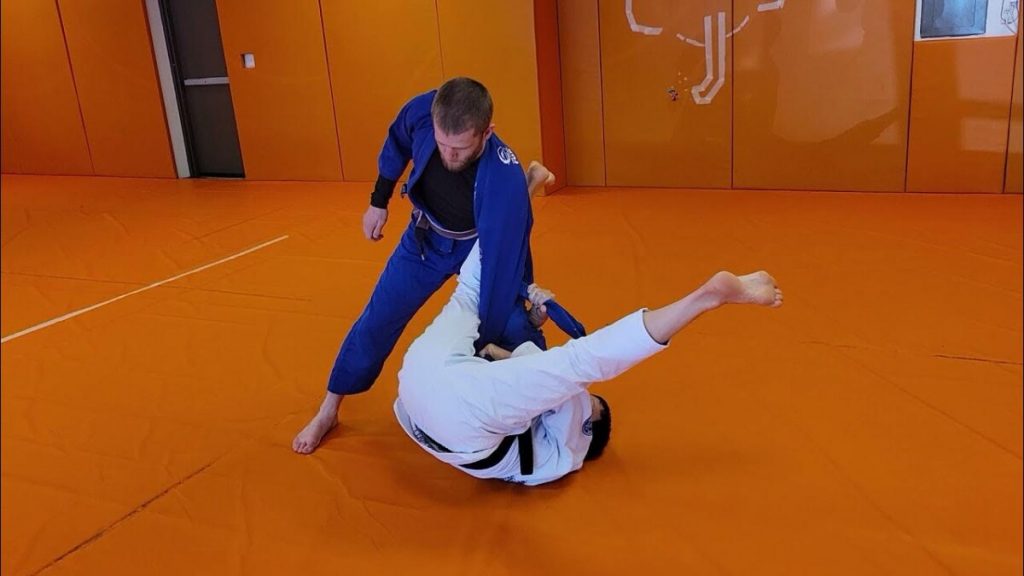BJJ Squid Guard: When lapel grips are used, BJJ is played quite differently. In terms of BJJ sport, it is a catalyst for innovation. Gi grips may be used in a variety of ways, some of which are already known to us and others of which are just waiting to be found. The growth of contemporary Jiu-Jitsu requires grapplers to adapt to and deal with the changes that result from the sport’s progress. We shall discuss the squid guard, a distinctive position, in this article.
BJJ Lapel Guards

The lapel is a crucial component of guard play in Gi Jiu-Jitsu. Techniques that focus on utilising the Gi to restrain and control an opponent’s mobility include the De La Riva, worm, galaxy, and squid guards. These guards provide you with the ability to control an opponent who is entirely resistant while presenting possibilities for a counterattack. The beautiful thing about the lapel is that we can wrap it around the opponent for sweeps or submissions since it can be used as an extension of our body.
Lapel guards also provide you the option to attack the opponent’s upper or lower body to alter their stance. You can move to other available guards or take on more powerful roles as a result. Although it might seem easy, lapel guards take practice since they are extremely technical and depend on the right body placement and grips. This emphasises how crucial it is to keep space between you and your opponent when using grip control.
Once a lapel player masters their favoured grips, even the most fearsome foe will find it difficult to resist. Lapel guards are difficult for many grapplers to handle because of their inherent intricacy.
You might also be interested in reading this: What An Intermediate BJJ Practitioner Should Know?
The BJJ Squid Guard: What Is It?

The skilled BJJ superstar Keenan Cornelius created the squid guard, a guard variation. When the opponent backsteps the leg you wish to control (near leg), the squid guard complements other lapel guards (like the worm guard) well. The opponent’s far leg, which is still in the same place after the back step, is now the focus of the squid guard.
The “squid guard” is a guard technique that takes advantage of the opponent’s lapel. When you get control of the opponent’s lapel below their near leg, you must slip it below their far leg and wrap it around to switch from the worm guard to the squid guard. You may disturb their posture and control their leg by pulling the lapel down in this way, opening up a variety of sweep options.
Instructions for the Squid Guard

Starting from the open guard, take a cross hold on your opponent’s right lapel. Control the opponent by putting your feet on their shoulders or hips and tugging on their lapel before attempting to take the position. Once the lapel is fastened, try to undercook your opponent’s right leg with your right hand by grasping behind the knee, just like you would when rolling an Imanari. Put your right foot past the right hip of the opposition. Swing your left leg to assist you in turning your body towards the right leg.
Even though you are not inverted, your body inverts and you place your head next to your adversary’s right foot. Transfer the grasp you have on the right lapel of the opponent with your left hand to your right. This positions the right lapel of the opponent to your right hand behind the right knee of the opponent while wrapping it around your right leg positioned on the right hip of the opponent. The friction and solid grasp control of this grip make it difficult for the opponent to release, which makes it difficult for them to get up. You are now in the squid guard position as a result.
The squid guard is quite similar to the lapeloplata. The lapeloplata differs from an omoplata because your leg is deeper in the opponent’s lapel and you have an omoplata-like bite there. As a result, the dynamics of the guard are altered, making it more difficult for you to employ various sweeps.
If the opponent rises up, you may use your left hand to pull the lapel down to maintain their posture thanks to the solid control you’ve created with the lapel grip with your right hand. You can start a lot of sweeps from here, but you can always go back to the squid guard posture. To swing around, switch grips with your palms pointing outward. The lapel grip allows you to control the opponent in numerous directions at once, which causes instability. Going back allows you to control the opponent in different ways. In a normal grip, such as the sleeve grip, you can only linearly control your opponent.
Preventing the opponent from stepping over your left foot and crouching down, much as how the top foot is positioned in the headquarters position, is one thing you need to watch out for. As long as you have a tight grasp on your lapel, the squid guard is one of the safest guards in all of Jiu-Jitsu. Even if they press the half guard and crush it, the opponent cannot cross your guard until they release the lapel grasp, regardless of where they position your free leg.
Using your free hand depending on how the opponent responds is an excellent piece of advice. With your free hand and leg, you may combine the squid guard with other open guards like the De La Riva and lasso. You will be in a secure position if you maintain the lapel hold below the opponent’s knee and move your foot past the opponent’s hip. If they press forward, you may frame into their hip to push them back.
Some of the biggest BJJ advancements in recent years include lapel guards. Studying and adding lapel modifications like the squid guard is always worthwhile because not all opponents have the ability and expertise to counter them, even though it leans more towards the sports aspect of the art.
This is everything about BJJ squid guard. Let us know your thoughts in the comment section below.

